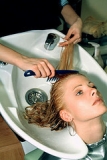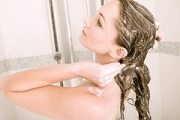Shampoo Your Hair

Shampoos are designed to cleanse the hair and scalp thoroughly, removing dirt, grease and grime without stripping away too much of the protective natural sebum. They contain cleansing agents, perfume and preservatives, and some have conditioning properties that can coat the hair shaft to make the hair appear thicker. The conditioning agents also smooth the cuticle scales so the hair doesn’t tangle, and help eliminate static electricity from the hair when it dries.
The pH Factor:
The letters pH relate to the acid/alkaline level of a substance. This level is calculated on a scale of 1 to 14. Numbers below 7 denote acidity, those over 7 indicate alkalinity. The majority of shampoos range between a pH factor of 5 and 7; medicated varieties have a pH of about 7.3, which is near neutral. Sebum has a pH factor between 4.5 and 5.5, which is mildly acidic. Bacteria cannot survive in this pH, so it is very important to maintain this protective layer in order to keep the skin, scalp and hair in optimum condition. Many shampoos are labelled “pH balanced”, and this means they have the same acidity level as hair. Individuals with fragile, premed or coloured hair should use a shampoo of this type. However, for strong hair in good condition, a pH balanced shampoo is unnecessary, provided shampooing is followed by conditioning.

How To Use A Shampoo:
Always use a product formulated for your hair type – dry, normal, oily or chemically treated – and before shampooing brush your hair to free any tangles and loosen dirt and dead skin cells. Use lukewarm water, as hot water can be uncomfortable. Wet the hair, then apply a small amount of shampoo and gently massage into the roots using the pads of your fingertips; never use your nails. Pay special attention to the hairline area, where make-up and dirt can become trapped. Allow the lather to work its way to the ends of the hair. Don’t rub vigorously or you will stretch the hair. When you have finished shampooing, rinse thoroughly until the water runs clean and clear. Repeat the process only if you think your hair needs it, again using only a small amount of shampoo. Finally, blot the hair with a towel to remove excess water before applying conditioner.

Massaging The Scalp:
Massage helps maintain a healthy scalp. It brings extra blood to the tissues, which enhances the delivery of nutrients and oxygen to the hair follicle. It also reduces scalp tension, which can contribute to hair loss, loosens dead skin cells and helps redress the over production of sebum, which makes hair oily. You can give yourself a scalp massage at home. Use warm olive oil if the scalp is dry or tight. Try equal parts of which hazel and mineral water if you have an oily scalp. For a normal scalp, use equal parts rose and mineral waters. Begin the massage by gently rotating your scalp using the tips of your fingers. Start at the forehead, move to the sides and work over the crown to the nape of the neck. Then place your fingertips firmly on the scalp without exerting too much pressure. Push the fingers together then pull them apart through the hair in a kneading motion, without lifting or moving them. When you have massaged for about a minute, move to the next section. Continue until your entire scalp and upper neck have been treated.

Shampoo Tips:
- Use the correct shampoo (and not too much) for your hair type. If in doubt use the mildest shampoo you can buy.
- Don’t wash your hair in washing-up liquid, soap or other detergents, they are highly alkaline and will upset your hair’s natural pH balance by stripping out the natural oils.
- Read the instructions first. Some shampoos need to be left on the scalp for a few minutes before rinsing.
- If you can, buy small packets of shampoo to test which brand is most suitable for your hair.
- Never wash your hair in the bath; dirty bath water is not conductive to clean hair, and it is difficult to rinse properly without a shower attachment or separate pourer.
- Always wash your brush and comb when you shampoo your hair.
- Change your shampoo every now and then; hair seems to develop a resistance to certain ingredients after a period of time.
- Don’t throw away a shampoo that doesn’t lather. The amount of suds is determined by the active level of detergent. Some shampoos have less suds than others but this has no effect on their cleansing ability. In fact, quite often, the more effective the product, the fewer the bubbles.
- Shampoos are available in different formulas to suit all hair types and conditions. Make sure you choose one that is right for your hair and use it as often as necessary to keep your hair clean. Rinse out shampoo thoroughly.
- For a really deep conditioning treatment, oils can be left on overnight to continue working while you recharge with a restful sleep.